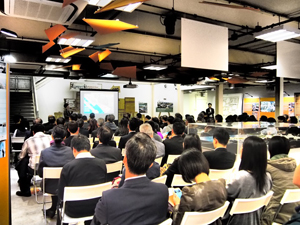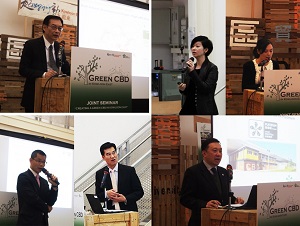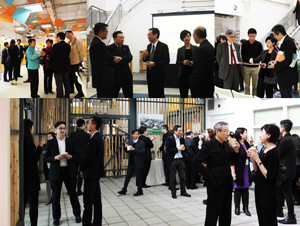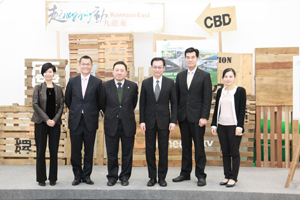Creating a green central business district in Kowloon East
|
Last Thursday, the Energizing Kowloon East office (EKEO) and the Hong Kong Green Building Council (HKGBC) jointly held a seminar entitled “Creating a Green Central Business District in Kowloon East”, attracting 110 participants who filled up the auditorium. Among the participants were professionals from the architectural, surveying, engineering and planning fields as well as private property owners, developers and other stakeholders from the local community. Their active participation shows that there is an increasing public awareness of a green living environment - an awareness that sets the future direction of Hong Kong’s development. In the past, the success of a city was determined by its economic performance. Today however, it is fairly clear that the general public wants a healthier city, a better quality of life and sustainable development, aspirations that have urged us to rethink and review our development model of the past. To enable people to live happily and enhance Hong Kong’s status and competitiveness, it is important for us to pursue the concept of sustainable development and adjust our urban development strategy from time to time. While Hong Kong is small compared with some cities, it still has plenty of people, cars and skyscrapers. Our urban planning, therefore, has to be in line with the principle of high-density and high-efficiency. It is our vision to develop Hong Kong into a “wise city”, i.e. a high-density, low-carbon, smart, walkable, livable and sustainable for the new generation. High density with mixed land uses – this means that development will be carried out both horizontally and vertically, from underground to high-rise construction, with integrated uses for residential, commercial/office, leisure and other facilities. In doing so, we intend to enable people to live and work within the same districts wherever practicable, so as to achieve a more balanced distribution of population and job opportunities and reduce the pressure on inter-district transport infrastructure. Meanwhile, a walkable and high-density urban development will be attained by connecting different places with pedestrian-friendly facilities. To support future new development areas, the Government will work out associated railway projects and encourage the use of electric vehicles. Low carbon – to meet the needs for sustainable development, we need to adopt innovative thinking, make efficient use of resources and build integrated green systems. At the same time, we should conserve the existing natural ecology as far as practicable and explore new opportunities for creating green public space. Smart – to achieve the goal of smart urban building, we have to explore innovation and the application of information technology, for example, the use of advanced waste-to-energy technology to treat waste produced in the community and generate energy for use in the local area. Moreover, an interactive information platform should be set up for better communication and sharing of data, so as to improve urban management, enhance efficiency and provide quality public services to improve the quality of life. Walkable – in overall planning, we intend to seamlessly connect the major urban centres, famous hot spots and important transport hubs all together, and provide a green walking environment with more pedestrian-friendly facilities. We have many valuable future opportunities to build Hong Kong into a “wise city”, with the new development areas in Kwu Tung North, Fanling North and Hung Shui Kiu, as well as Lantau which is not yet fully developed. In Kowloon East, we have the clear goal of expediting the transformation of this old industrial area into another attractive central business district. Kowloon East has an area of 488 hectares covering the former the Kai Tak Airport, Kwun Tong and the Kowloon Bay Business Area. Formerly a key industrial base, the area witnessed the glory days of Hong Kong’s manufacturing industry. With its transformation into an attractive central business district, it will turn a new page in Hong Kong’s history. In the course of its transformation, we should seize the opportunity and use our creativity together to bring more green elements into the district. Kai Tak Development (KTD) The former Kai Tak Airport is gradually transforming into a distinctive, vibrant, attractive and people-oriented community next to Victoria Harbour. We really hope that it will go one step further by becoming a unique waterfront area in the urban area of Hong Kong, offering a combination of residential, commercial/office, green building, sports, recreation and tourist facilities. The KTD is a large-scale, comprehensive project with an extensive area of 320 hectares adjacent to Victoria Harbour. In line with the planning principle of people-oriented and sustainable development, the project will not only enhance the connection between the community and the harbourfront, but also provide an excellent network of open space and parks. In the near future, about one-third of the Kai Tak area will be developed into green public space for public enjoyment, together with an 11-kilometre waterfront promenade, which is equivalent to one-seventh of the length of the Victoria Harbourfront. Kwun Tong and Kowloon Bay Business Area Unlike the Kai Tak area, Kwun Tong and Kowloon Bay are like two hidden gems. The EKEO is adopting the place-making strategy of rejuvenating these two places into a greener and more vibrant central business district for the 260 000 people now working in the districts. Since the establishment of the EKEO, we have been promoting the transformation of Kowloon East through three initiatives, namely enhancing connectivity, improving the environment and releasing development potential. On “enhancing connectivity”, we are actively promoting the concept of a “walkable Kowloon East”. We have commissioned various feasibility consultancy studies to formulate short-, medium- and long-term proposals for improving the pedestrian and traffic environment. Most of the works under the short-term proposals have been completed. In future, when improving the pedestrian environment, we will also implement the Greening Master Plan of Energizing Kowloon East and increase the leisure facilities in the locality, so as to reduce public demand on road traffic and thus reduce carbon emissions. On “improving the environment”, we have completed a number of projects this year, with Tsun Yip Street Playground Phase 1 being the most representative of Kwun Tong’s distinctive features. The playground has been transformed into an industrial heritage park under the theme “Spirit of Creation”, passing on the industrial heritage of Kowloon East by incorporating it into innovative designs and public art used in the course of urban transformation. The improvement of the harbourfront environment is also crucial to the development of a green community. We have utilised the area underneath the Kwun Tong Bypass to create the “Fly the Flyover01, 02 and 03” sites to provide artists, art groups and the creative industry with room to work. With the adjacent promenade park due to be completed early next year, as well as the ecological and landscaping upgrading programme for converting the King Yip Street Nullah into Tsui Ping River, more public leisure space will be provided in the district. On “releasing development potential”, we plan to transform the Kowloon Bay Action Area and its adjacent areas into a “Green Community”. Meanwhile, through the launch of the Kai Tak Fantasy project, the former airport runway tip, Kwun Tong Action Area and the enclosed water body will be released so as to promote the concept of a green healthy city and transform the former Kai Tak Airport into a world-class green tourism, entertainment and leisure hub for the enjoyment of the community. To realise the dream of a green Kowloon East, solely relying on the Government’s efforts is not enough. I sincerely hope that you will all work with us to turn a new page for Kowloon East. Since 2012, we have been exchanging views with the stakeholders in the community and promoting our green concepts. We have also incorporated new greening requirements into the land leases for private development projects in Kowloon East, including the requirement for development projects to secure the BEAM Plus Gold rating or above and to provide additional green areas. After two years of hard work, 10 projects in Kowloon East have received a Gold or above rating. We expect to seize the opportunity to promote more innovative green projects in collaboration with various parties, so as to transform Kowloon East into our first-ever green central business district as soon as possible. For more details about the “Creating a Green Central Business District in Kowloon East” seminar, please visit the EKEO website at http://www.ekeo.gov.hk/.
|
|
14 December, 2014
Back



